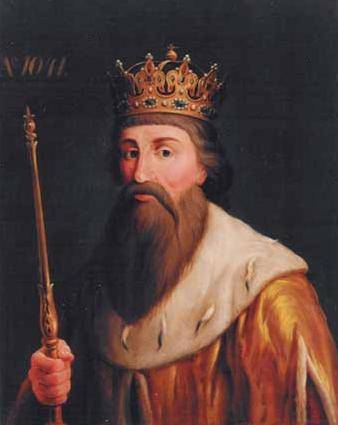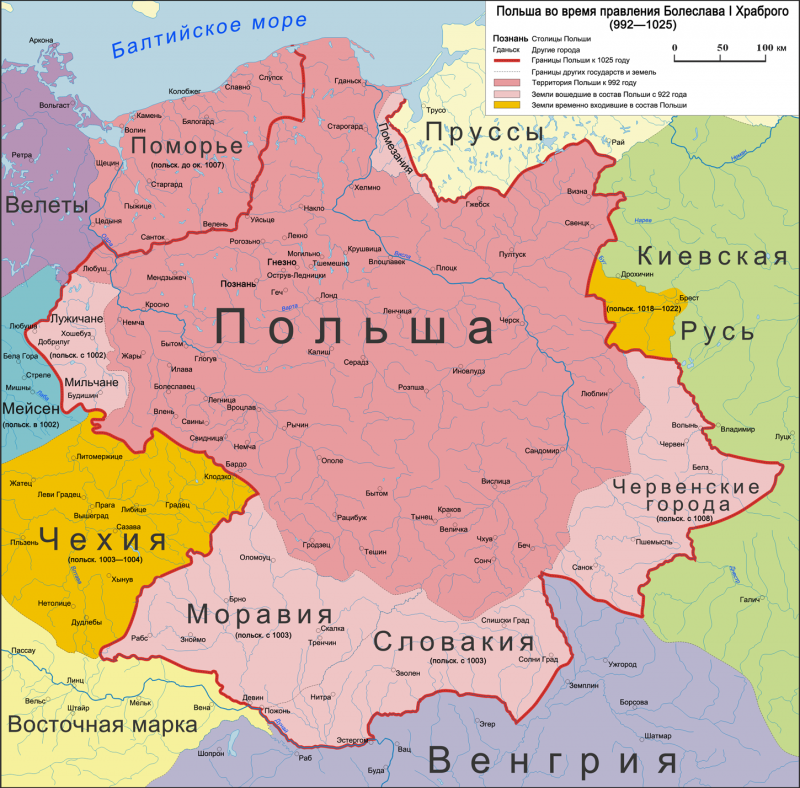How Yaroslav the Wise helped restore Poland
The collapse and restoration of Poland
The end of Boleslav the Brave's rule was marked by increasing instability - internal and external. With the Second Reich was the world, but cold. The Czech Republic and Hungary were unhappy with the capture of Moravia and Slovakia. In 1021, the Czech Republic was able to recapture Moravia. Boleslav was in conflict with the Catholic elite and the major feudal lords of Poland. In 1019-1022 there was a Russian-Polish war for the Cherven cities captured by Boleslav. Boleslav was able to keep Chervonnaya Rus under his rule. However, there was hostility between Russia and Poland.
In 1025, a few weeks after his coronation, Boleslaw the Brave dies. In Poland, strife begins between Boleslavichi - the new king Mieszko II and his brothers Besprim (Free) and Otton Boleslavichi. After the death of Boleslav, the brothers expected to receive part of the inheritance: according to the Slavic custom, the father had to divide the property into all the sons. However, the kingdom went to only one son. Bezprim and Otto fled to Kiev, under the wing of the great Russian prince Yaroslav the Wise. In Kiev, the brothers spent several years. At the same time, Otto entered into an alliance with the German Emperor Conrad, wanting to take away the Polish throne from his brother.
In 1030, Yaroslav launched a war with Poland and fought off the city of Belzy (Belz) in the region of Chervonnaya Rus. According to the Russian chronicles: “Yaroslav and Mstislav gathered many warriors, went to the Poles and occupied the cities of Chervensky again, and fought the Lyakh land; and many Poles were brought and divided: Yaroslav planted his own along Ros; and they remain there to this day. " Having mastered the cities of Cherven, the Russian princes continued their march into the depths of Poland in order to put Bezprima on the throne. The campaign of the Russian army in Poland was synchronized with the advance of the troops of the German emperor to the west. Meshko could not simultaneously stop the Russians and the Germans and was forced to flee to Bohemia (Czech Republic). In addition, many major secular and spiritual feudal lords opposed Meshko. Meshko, to fight Germany, concluded an alliance with the pagan tribes of the Lyutichs. This caused Mieszko’s discord with his entourage; he was even declared a pseudo-Christian. Bezprim with the support of Russian and German troops seized the throne of Poland and recognized the emperor's suzerainty. This displeased Otto and he moved to the camp of the supporters of Mieszko II.
The board of the besprima did not last long. It is believed that the cause of his fall was his extreme cruelty. According to the Annals of Hildesheim, he was killed by his own people no later than the spring of 1032. Probably the main conspirators were his half-brothers Mieszko II and Otto. The main conspirator was Otto, who remained in Germany. After the overthrow of the Bezprima, the country was divided into three parts: between Meshko II, Otto, and their cousin, the prince Dietrich (Piast). This led to a significant increase in the influence of the Holy Roman Empire (Germany) on the affairs of Poland. Sack II takes the oath to the emperor Konrad II and gives the land to the Second Reich of the Lusatians and milchanas. Poland lost its kingdom status for almost half a century and became a vassal of the Second Reich.
However, the victorious Boleslavichs did not rule for long. Otto died in 1033, he may have been killed by his vassals. In 1034, the conspirators killed Meshko. Poland plunged into turmoil. It is not even known who began to rule. According to one of the versions, the eldest son Mieszko Boleslav Forgotten occupied the throne. He ruled extremely unfortunate. Because of such activities, he was allegedly condemned to eternal oblivion ("the condemnation of memory"). His short reign, before 1037-1038, led to a confrontation between the great princes and large feudal lords. In Great and Little Poland, secular feudal lords were also supported by the spiritual (clergy). In Pomorie, local nobility resorted to the idea of restoring paganism. The situation was similar in Mazovia. Death of the Grand Duke in 1037 or 1038 led to the beginning of the peasant war. The Russian Chronicle reports very briefly about this time: “there was a revolt in the land of Lyadsk: after rising, the bishops, the priests, the boyars, and the revolt were in them”. The peasant and pagan uprising shocked the entire Polish statehood. Only in large cities - Krakow, Poznan, Gniezno - somehow remained the remnants of the state apparatus. A single Polish state, in fact, did not exist then.
According to most historians, the Polish queen Ryks (Ricks) of Lorraine tried to rule after Meshko, who took custody of her young son Casimir. Ryksa tried to push the Polish nobles from power, and to rule with the help of the Germans loyal to her. The case ended with a new coup and the flight of Ryksy with children to Germany. Polish steel magnates rule in the name of the young King Casimir. But the situation was awful. In the country since the struggle of Boleslawicz, the struggle between the gentry and the peasantry, caused by the socio-economic and religious pressure of secular and spiritual feudal lords on the peasants, who were quickly enslaved. But they still remembered their past rights and freedoms. A large-scale peasant war began. In addition, Christianity, forcibly introduced in a pagan country, led to a response — a wide pagan rebellion. In Great Poland and Silesia, the church organization was destroyed, churches (churches) and monasteries were destroyed. Pomorie and Mazovia separated from Poland, where local dynasties were established. In 1038, the Czech army led by Břetislav took Gniezno. Perhaps the Czech prince wanted to take advantage of the distemper in Poland in order to take over most of the state. But in conditions of large-scale collapse and distemper, he could not and limited himself to seizing large booty, many prisoners and annexed Silesia with Wroclaw to the possessions of the Czech crown.
Russia during this period did not interfere in Polish affairs. Yaroslav was satisfied with the return of the “Cherven Grads”. Order in Poland was restored with the help of the Second Reich. Fearing the restoration of paganism in Poland and its subordination to the Czech Republic, Emperor Henry III decided to come to the aid of Casimir. With the help of the German troops in 1039, Casimir I (he reigned until 1058), nicknamed the Restorer, restored his power in Poland. Peasant and pagan uprisings suppressed, aristocrats pacified. However, for the help of the emperor, Poland recognized the suzerainty of the Holy Roman Empire.
Casimir, the Great Poland and Lesser Poland feudal lords did not have enough strength to restore the unity of the country. Then Casimir decided to ask for help from Russia. Casimir and Russian prince Yaroslav concluded an alliance. It was the greatest diplomatic success of Prince Casimir. Together they led the fight against Moislav (Maslava) - the former warrior Mieszko, who seized power in Mazovia. Moseslav was supported by the Prussians, Lithuanians and Pomors. In 1041, Yaroslav’s troops marched to Mazovia. At the same time, Russian troops marched along the rivers Pripyat and Western Bug. In 1042, Casimir married the sister of Grand Prince Yaroslav of Kiev, Dobronega (in baptism - Mary), receiving a rich dowry. Kazimir gave 800 prisoners to Yaroslav, whom Boleslav captured in Russia. In 1047, Yaroslav again led the army to help Casimir. Prince Moislav was killed, his army crushed. Mazovia again became part of the Principality of Poland.
The union of Russia and Poland was sealed by another marriage - the son of Yaroslav Izyaslav married Casimir’s sister. Until the death of the great Russian prince Yaroslav in 1054, good relations with Poland remained. Thus, only the support of Russia allowed Poland to return Mazovia to the principality.
Less successful was the policy of Casimir in Pomorie, where the nobility was oriented toward the Czech Republic. In addition, the Second Reich pursued such a policy in order to preserve the balance of power between Poland and the Czech Republic, fearing the excessive strengthening of one of the powers. Every success of Poland inevitably irritated the German Empire. In 1050, there was even a threat of the campaign of Emperor Henry III, against the "rebellious Casimir." As a result, the position of Germany, however, did not allow the return of Pomerania to Prince Casimir. Only East Pomerania recognized the power of Poland, and West Pomerania retained autonomy. There, the rules of their own dynasty, which outwardly recognized vassal dependence on Poland, but was independent in its policy. In 1054, the Silesia was returned to the Polish state at the cost of paying a tribute to the Czech Republic.
Thus, Poland restored unity. However, the royal power of Casimir could not be restored. This task was inherited by his son, Boleslav II the Bold.

Casimir I the Restorer

Information